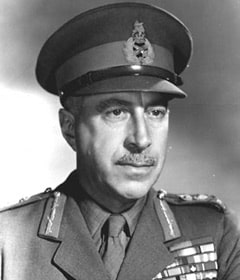One of Canada’s greatest wartime commanders, General Crerar was born and educated in Hamilton, Ontario. Graduating from the Royal Military College in 1909, he took a position with the Ontario Hydro-Electric Commission, Toronto.
At the outbreak of the Great War, he was a Lieutenant in Toronto’s 4th Battery, 2nd Brigade, the Non-Permanent Active Militia. He immediately joined Canada’s First Division, going overseas with the First Contingent. He served in France, initially with the 3rd Field Artillery Brigade, later as Brigade Major of the 5th Canadian Divisional Artillery. A recognized leader in the development of modern artillery, he designed the most massive, most intricate and successful creeping barrage in the latter days of the war. This three-day barrage at the Canal du Nord halted the final German advance and was considered a brilliant use of artillery. His exceptional work was recognized in the award of the Distinguished Service Order. By October 1918, he was a Lieutenant-Colonel.
After the war, he remained in the army and was appointed to the General Staff, Ottawa. Following attendance at the British Staff College, he returned to Kingston as Professor of Tactics, Royal Military College. He represented Canada at the 1932 Geneva Disarmament Conference and the London Imperial Conference of 1937. In 1935, he was promoted to Colonel with the appointment as Commandant, Royal Military College.
Immediately following the declaration of war in 1939, he was promoted and dispatched to Britain to prepare for the arrival of the Canadians. In July, the following year, he returned to Ottawa, a Major-General and chief of the General Staff. In 1941, he was promoted to Lieutenant-General.
Late in 1941, he returned to England to command the 2nd Canadian Division, reverted to Major-General. On arrival, he became a temporary Corps Commander and was promoted to Lieutenant-General for the second time. In April 1942, he was given permanent command of the 1st Canadian Corps.
“Uncle Harry,” as his senior staff affectionately called him, assumed command of the First Canadian Army, 20 March 1944, less than three months before the allied assault on Normandy. By August, after Caen had fallen, he commanded the Canadian troops in the field. As well as three Canadian Divisions (the 2nd, 3rd and 4th), the Polish First Armoured Division, the British 49th (West Riding), and 51st (Highland) Divisions were to remain with him almost to the end of hostilities. During his campaign, American, Belgian, Czech, Dutch and French forces were attached to his army. He was adept at getting the best from these widely-differing forces.
After the Canadians broke the Caen “hinge”, he directed one of the great battles of the war, throwing his formations into Falaise and closing the Trun Gap. The great pursuit followed this through France and Belgium, which extended from Le Havre to the Scheldt estuary and Antwerp. This extended front required him to spend much of his time visiting the British divisions in Le Havre, the 3rd Canadians at Boulogne and Calais, the 4th Canadians at Bruges and Ostende, the Poles at Terneuzen, the Americans near Turnhout and the 2nd Canadians in Antwerp, which was an outstanding feat by any measure.
After the bloody battles of the Leopold Canal, the Breskens Pocket and Walcheren Island, he led his army into the Nijmegen salient to prepare for the final assault into Germany.
In February, he threw his army against the Northern flank of the Siegfried Line, a prelude to winning the great battles of the Reichswald and Hochwald forests, thereby setting the stage for the great British and American drives into the Ruhr and the plains of northern Germany.
With the addition of the 1st Canadian Corps from Italy, he launched his forces through western and northern Holland and northwestern Germany. It was here that the war ended for the First Canadian Army. The King honoured him, appointing him to the Order of the Companions of Honour.
He was the first Canadian to gain the rank of General while on active service at the front. His contribution to the Canadian Military and the war effort was immense. Their victories had a significant bearing on the Allied advance through France, Belgium, Holland and into Germany.
He retired in 1946 after serving Canada for more than 35 years. His career spanned two world wars, decorated by France, Belgium, the USA, Poland and Holland.
One of the most distinguished military leaders produced by Canada, he died in Ottawa in 1965.

